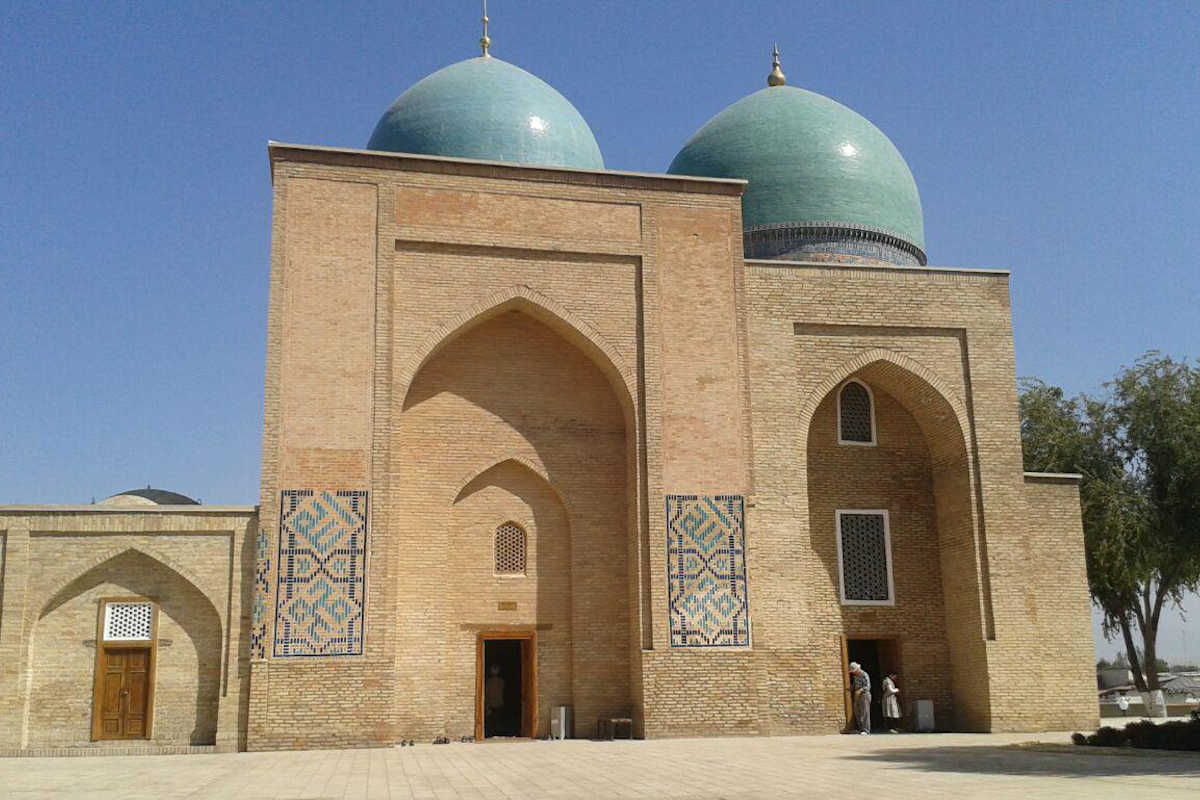Shakhrisabz - Dorut Tilovat Ensemble

The Dorut-Tilovat ensemble in Shakhrisabz – a centre of spiritual and architectural splendour
The Dorut-Tilovat ensemble in Shahrisabz is one of the most important historical sites in Central Asia. It comprises three preserved buildings that were erected on the former necropolis of the nobility of the Barlas dynasty:
- The Mausoleum of Hazrati Sheikh (Shamsiddin Kulol),
- The Gumbazi Sayidon Mausoleum,
- The Kok Gumbaz Jome Mosque.
These monuments are the last remnants of an extensive architectural complex once known as the Dorut-Tilovat madrasah (‘House of Contemplation’).
With its impressive domes, intricate decorations and deeply rooted spiritual traditions, the Dorut-Tilovat ensemble is a living testimony to the Temurid era. It not only served as a place of religious teaching, but also as the final resting place of important personalities.
The mausoleum of Shamsiddin Kulol – the spiritual cradle of the ensemble
The oldest building within the ensemble is the mausoleum of Shamsiddin Kulol, who played a central role in the religious development of the region as the spiritual teacher and mentor of Amir Temur and his father, Amir Taraghai.
Shamsiddin Kulol, also known as Amiri Kalon (‘Great Emir’), was one of the most influential Sufi masters of his time. He is regarded as the teacher of the famous Sheikh Bahauddin Naqshbandi, the founder of the Naqshbandi Sufi order. His teachings emphasised:
- “Treading the path of God in silent meditation’ (Zikr-i-Khafi), a form of “Secret Zikr”.
- “Good deeds only unfold in a community based on mutual respect”.
Shamsiddin Kulol died in 1370, whereupon his grave quickly became an important place of pilgrimage. To honour his mentor, Amir Temur had the Dorut-Tilovat memorial complex built in 1370-1371.
The importance of the complex grew further when Amir Temur had his father Amir Taraghai buried in this sacred place. The transfer of his mortal remains to one of the rooms of the madrasah lent the site additional symbolic power.
The architectural splendour of the mausoleum
During the reign of Amir Temur, the tomb of Shamsiddin Kulol was covered with precious marble slabs to emphasise his importance as a great religious figure.
Later, under Ulugbek, a mausoleum with an imposing dome was built over the tomb.
The architecture of the building follows the classical style of the Temurid dynasty, which is characterised by:
- ornate majolica decorations,
- monumental proportions
- and calligraphic inscriptions.
This mausoleum replaced an earlier, more modest tomb and made Dorut-Tilovat one of the most important religious centres of the Temurid period.
The Kok Gumbaz Dome Mosque – The ‘Blue Dome’ of Shahrisabz
In 1435, Ulugbek, the grandson of Amir Temur and one of the most important astronomers and rulers of the region, had the large Friday mosque Kok Gumbaz built.
- An inscription on the portal of the mosque reveals that it was built by order of Ulugbek for his father Shahrukh.
- The architecture of this building impresses with its monumental dome and harmonious symmetry.
The mosque is not only one of the largest houses of prayer in Shahrisabz, but also served as the religious and community centre of the city.
Gumbazi-Sayidon – the royal tomb
The Gumbazi-Sayidon mausoleum, also part of the Dorut-Tilovat ensemble, was built for members of the Temurid dynasty. It houses the tombs of several descendants of Ulugbek.
Its architecture shows:
- A dome in bright blue, reminiscent of the Kok Gumbaz mosque.
- Richly decorated interior walls with calligraphic elements.
This mausoleum completes the ensemble and emphasises the importance of Shahrisabz as a royal burial site.
Dorut-Tilovat and Dorus-Saodat – a monumental necropolis
The Dorut-Tilovat ensemble is located south of the ruins of the Ak-Saray Palace and not far from the historic Charsu monument and the city market.
- Due to its slightly elevated position, this complex stands out from the rest of the city.
- Just 200 metres to the east is another monumental building: Dorus-Saodat.
Together, these two complexes formed a unified necropolis of Shahrisabz. Amir Temur ordered their construction in order to:
- honour the memory of his father Amir Taraghai (d. 1360),
- his spiritual advisor Shamsiddin Kulol,
- and his eldest son Mirza Ghiyasiddin Jahongir (d. 1376).
The historical significance of the necropolis
An extensive cemetery once stretched between the two ensembles. The necropolis served as the final resting place of numerous nobles and dignitaries.
During the Soviet modernisation of Shahrisabz, however, the use of this cemetery was discontinued. Today, the grounds have been landscaped and planted with trees, giving the historic site a park-like character.
Dorut-Tilovat today – a living legacy of the Temurids
Today, the Dorut-Tilovat ensemble is an important place of pilgrimage (Ziyarat) and attracts believers and history buffs from all over the world.
Conservation measures and restorations:
- The marble façade of the mausoleum was restored.
- The inscriptions have been conserved in order to preserve its cultural heritage.
- The entire complex has been made accessible to visitors.
For travellers, the Dorut-Tilovat ensemble is a central place of reflection and admiration. It combines the spiritual depth of Sufism with the architectural mastery of the Temurids and remains a shining symbol of Islamic culture in Central Asia.
